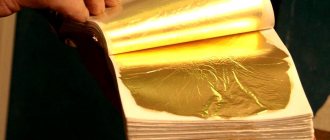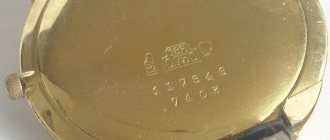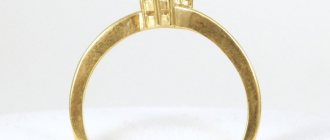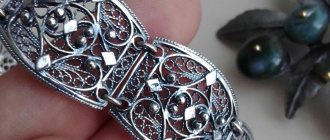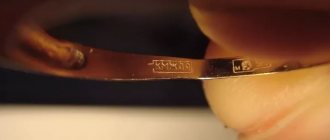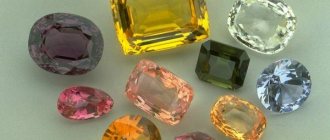Applications and features of gold
Now purple gold has a very wide range of applications. This is not only the jewelry industry, but also the art industry. This gold is widely used by craftsmen to create pieces of incomparable beauty with porcelain. It is also used to create ruby-colored products, which are obtained by adding it to molten glass.
Amethyst gold inserts in earrings
However, it was the violet color of the metal that most attracted jewelers. Very popular are products that combine several types of metal - purple is combined with white or yellow. Purple gold looks beautiful in combination with blue and cyan, which are also rare.
An alloy of this color has advantages. It has good skin compatibility. Even after prolonged wear, such jewelry does not cause reactions in the form of allergies. This is due to the safety of the alloy, as well as the high percentage of base metal in the alloy of 75-80%.
Doctors recommend wearing purple gold to people who are sensitive to other less high-grade alloys. And its combination with white makes jewelry suitable for any type of appearance. Plus, they look so elegant that they go with any outfit.
How to wear such gold?
Unfortunately, the alloy does not have the best characteristics for use. Products require careful storage and handling. If you go to the website of the Singapore company (the world's most famous producer of purple gold), you can see recommendations for caring for the products. This helps to extend the service life and preserve the appearance and quality. You need to do this correctly:
- Jewelry should not be subjected to mechanical stress or contact with chemicals.
- It is not recommended to clean this type of jewelry, take a shower or wash dishes; avoid any contact with water.
- To remove smudges and fingerprints, use a cloth dampened with water. Be sure to dry the product with a cloth or napkin after this.
Since purple gold is rare and fragile, products are almost never made entirely from it. There may be inserts or inclusions in standard alloys. And if it is necessary to make a large part of the decoration, then a frame made of stronger metal is used. The disadvantage of this alloy is oxidation, which leads to the jewelry losing its appearance.
In addition, when purchasing a product, you should take into account one more point - you will not be able to repair it. Nobody does this, not only because few craftsmen are familiar with it, but also because both remelting and the inclusion of solders can disrupt the integrity of the alloy, because the manufacturing technology is still not fully known.
There is also purple gold produced in Turkey. Its production technology differs from Singapore's, which leads to losses in brightness and color saturation, but the cost is much lower.
Receiving technology
At the beginning of the 20th century, physicist Robert Wood discovered that in order to obtain purple gold, it is necessary to add 25% aluminum and palladium to the alloy. Many experiments were carried out in order to combine these components and obtain an alloy of this color, but they ended in nothing. Only after 20 years of work, metallurgist Lo Peng Cham from Singapore was able to improve the recipe so much that he finally got it in the way that was necessary for use in jewelry. The same metallurgist also worked on the creation of black and green gold.
What was the difficulty in obtaining violet gold, since we know what metals must be alloyed to produce such a color? At first there were attempts to alloy the base metal with aluminum: the connection of these two metals is an intermetallic compound, which is very brittle and cannot be processed. By the way, the temperature to which the alloy is heated to produce this color is 5000 degrees, which is 5 times higher than the temperature at which gold melts.
Then, to improve the characteristics, they began to experiment with the addition of other metals. We tried many of them, for example, cobalt, magnesium, silicon, but they did not work. Later it was determined that palladium was suitable for these purposes. But then a new problem arose: how to fuse together three such different metals, because each of them had a different density and melting point.
Does gold come in different colors?
The Iron Forest trails of Norse mythology and imagination led me primarily to green gold.
As some sources say, the leaves on the trees in this forest were made of iron. If they are made of iron, then most likely they have become rusty over time. And it brought such melancholy that I imagined the leaves in that forest in spring and summer of different shades of green, and in the fall - of gold and silver.
I think there were no problems with gold and silver, but green metal...
It turned out that even in the 1st–2nd millennia BC, people knew a natural alloy of gold and silver, which had a greenish tint. The alloy was called electrum. Jewelry and religious objects were made from it.
Lydian electrum coin, 6th century BC. e. Photo: ru.wikipedia.org
In Ancient Egypt, obelisks and the tops of pyramids were covered with such gold. According to researchers, electrum was delivered to Egypt from East Africa.
In the 7th century BC, in the ancient state of Lydia, coins were minted from electrum. For these purposes, a natural alloy of gold and silver was mined near the Nile River. Museums contain coins made during the time of King Croesus. They have a yellow-green color.
Natural reserves of electrum were small, and its use was not widespread throughout the world.
In Ancient Egypt, the tops of the pyramids were covered with electrum Photo: pixabay.com
But in the 19th century, interest in green gold was revived. During the experiments, various metals were added to gold.
- A base alloy was obtained, casting a yellow-green color in the light, consisting of 73-75% gold and 27-25% silver.
- When 23% copper and 2% cadmium are added to gold, a light green color is obtained.
- If silver, copper and cadmium are added to gold in certain proportions, a dark green color is obtained.
But given the toxicity of cadmium to the human body, it is rarely used for alloys used to make jewelry.
Green gold ring Photo: pixabay.com
Alloys of gold with various additives are called metalloids. Nowadays, metalloids used in jewelry production are subject to certain requirements.
- First of all, additives that cause allergies in humans, as well as those that react with oxygen and other substances from the environment, are excluded.
- The second important requirement is the behavior of the alloy during operation - it must be hard and durable, but at the same time sufficiently ductile to be subject to bending and torsion.
Chains, pendants, earrings, rings, including wedding rings, brooches, and bracelets are made from green gold. It is used to decorate wristwatches, combs, and medallions. Green gold perfectly sets off green gemstones. Products made from it look unusual and elegant.
Prices depend on additives. But in any case, the cost of green gold is high and occupies one of the first places in the list of non-ferrous metals.
White gold ring Photo: Source
White gold is an alloy of gold with whitening metals, nickel, platinum, palladium, zinc, and manganese. Depending on the additives, gold is obtained with different characteristics. Copper is also added to these alloys to increase ductility.
In jewelry, alloys of gold, palladium and silver or gold, nickel, copper and zinc are most often used. Zinc is used as a secondary bleaching agent if copper is added.
In many countries, nickel is not used in alloys because it is an allergen.
Red gold ring Photo: Source
When copper is added to gold, they obtain, depending on the proportion of copper, rose or red gold , which is widely used in the jewelry industry for the manufacture of wedding rings, rings, bracelets and other jewelry.
In red gold, copper is 25% or 50%, in rose gold - 22.75%, plus silver 2.75%; or 20% copper and 5% silver.
To obtain a red-yellow or dark yellow color, up to 15% zinc is added to enriched copper before combining it with gold.
By the way, in ancient times, due to impurities during the melting of gold, it had a reddish tint, so in ancient texts the epithet “red” was used for gold.
Purple Gold Photo: Source
Purple , or violet, amethyst, gold is interesting It is obtained by alloying gold and aluminum; gold in this alloy is about 79%. Purple gold is fragile, so in jewelry it is used only as inserts.
But thanks to the hard work of Professor Lo from Singapore in 1999, a technology for the production of malleable amethyst gold was created. It consists of 80% gold and 20% aluminum and other metals. The new product was introduced to the world market in 2003 and was highly praised by experts.
The price of amethyst gold, due to the complexity of the technological process, is much higher than the price of ordinary gold.
Blue gold ring Photo: Source
Little-used blue gold is an alloy of gold and indium, with less gold in the alloy than additives, so it is not a standard gold. In addition, its color is not clear blue, but is characterized as grayish.
When gallium is added instead of indium, a bluish tint appears. The indium alloy is less brittle and is sometimes used as a solder to repair white gold items.
To increase the purity of blue gold to standard, it is necessary to reduce the proportion of additives, but then the bluish tint completely disappears.
Black gold ring Photo: Source
And finally, black gold , which is obtained using modern technologies.
Nowadays, science and production are developing rapidly, and the time is not far when jewelers will have gold of all colors of the rainbow at their disposal.
Tags: jewelry, gold, gold alloys, modern technologies, white gold
Where can I buy and what is the price?
The inventor sold his research to a Singapore company, and they still keep the production technology secret. Therefore, real purple gold can only be bought in Singapore. Please note that the products must bear the QJS badge, which indicates the high quality of the product. It is best to purchase gold in the chain of stores of the manufacturing company Aspial-Lee Hwa Jewelery.
The cost is quite high; they say that a small bracelet with purple gold inserts can be purchased for 1-1.5 thousand dollars. The most expensive item to date was sold for $55,000 at auction.
Getting purple gold in your collection in the form of jewelry is the dream of almost every jewelry connoisseur and everyone who follows fashion. Leading jewelry houses include products with purple gold in their collections. It is also purchased by celebrities and the richest people in the world. Ordinary people rarely purchase such jewelry, although they are popular.
Purple gold
There are only a few pieces of jewelry made entirely of purple gold. The metal oxidizes quickly, is not ductile, and is fragile. All this complicates the work of jewelers. Craftsmen use an unusual type of precious metal only as inserts. Most often, the purple element is cut like a stone and made the center of the composition. If it seems that the ring or bracelet is made of solid gold with an amethyst hue, then this is not so. Inside the product there is a frame made of another, more durable metal. Without it, your exotic jewelry may break the first time it is dropped.
You can buy purple gold , but it cannot be found in nature. This is not an ore, not a pure metal, but an alloy. The precious element acquires its amethyst hue when combined with aluminum. The composition is awarded the 750th standard, since it contains 75% gold. However, if you pay attention to the number of atoms of the two components of the alloy, there are more aluminum particles in it. This element has a much lower atomic mass. Therefore, 25% of the alloying metal contains more atoms than 75% of the gold base.
The material is not only difficult to process. It's not easy to get. In Russia, for example, they don’t do this at all. The melting points of gold and aluminum vary greatly. Yellow metal requires 1350 degrees Celsius, and white - only 660. This makes the casting process very labor-intensive.
A different approach has been found. So far, developments are being carried out only by scientists. In our country, they are working on the creation of non-ferrous gold at the Institute of Physics of Non-Ferrous Metals of the Ural Branch of the Russian Academy of Sciences. We have already patented the technology of oxidation and subsequent polishing of the gold base to the matrix material. Metal nanopowders help the researchers in their work. The synthesis of gold, crushed to such sizes, with other elements is much easier than during remelting. The method allows you to obtain black, yellow, purple raw materials. The technology will be used on an industrial scale only if it can be made cheaper. In South Africa, for example, they could not do this. Several years ago, an African state also developed a method for creating colored gold using laser exposure. It “didn’t go down well with the people”; products using the new technology were too expensive.
So for now, just melting. The strongest purple alloy was developed by Lo Peng Cham. This is a professor from Singapore. Since 1976, the metallurgist has been struggling with the ideal formula and improved the production process. In 1999, the scientist presented to the public his creation - a 19-carat purple alloy. It contains 80% gold. The remaining 20% includes aluminum and palladium. Their proportions have not been disclosed. The numbers are known only to the Singapore corporation Aspial-LeeHwaJewellery. It was she who bought the rights to present rare gold on the market from Lo Peng Cham. It has maximum strength compared to other options sold in jewelry stores.
The first creation of the jewelry masters was a necklace valued at 55 thousand dollars. It combined three types of gold – yellow, white and purple. The latter was forged into petals woven into massive chains. The total weight of the jewelry was more than 19 carats.
The purple alloy, like its yellow counterpart, does not cause skin reactions. Exotic gold can be worn even by those who suffer from allergies. The cost of unusual gold is one and a half, or even two times more than standard gold. True, selling it is not easy. In the price lists of pawnshops there is no line “purple gold” or even “colored gold”.
It is worth noting that purple color is not only produced in tandem with aluminum. This mixture is rather purple. Gold is called violet, but true violet is obtained by combining the precious raw material with another metal - potassium. The combination with it also gives green paint, it all depends on the proportions. For example, with regards to aluminum, the limit is 12%. If the amount of white element in the alloy is less, amethyst gold will not come out. Potassium is required from 20%. A smaller amount will give an olive color.
They present purple gold photos that depict the attributes of Tutankhamun’s power. The items were found during excavations in 1931. It turns out that the ancients also possessed the wisdom of creating a purple alloy. But, in the 2nd millennium BC, the recipe and technology were lost. People haven't seen purple gold for two millennia. Robert Wood rediscovered it to the world. Inspired by the results of archaeological excavations, a physicist from the United States created his own purple alloy. Most of the metal of the Egyptian pharaohs was placed in the Cairo Museum, where evidence of the antiquity of the purple alloy can still be seen.
Purple gold can also be seen in the wilds of the Amazon. True, in the form of berries. This is the name of acai - round fruits of a rich purple color. Tropical berries are a storehouse of vitamins. They are rich in fats, proteins, fiber, and minerals. Acai contains everything the body needs to stay healthy and young. Therefore, the fruits are called gold, although metal is, perhaps, the only thing that is not in them.

